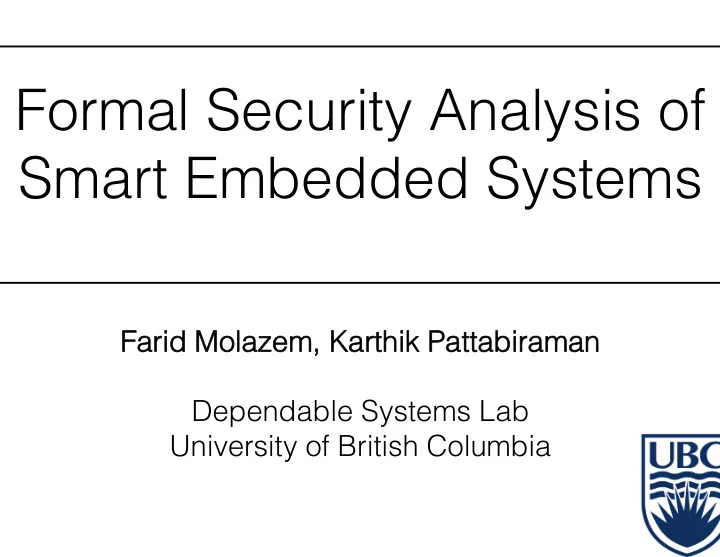

� � Formal Security Analysis of Smart Embedded Systems � Farid Molazem, Farid Molazem, Karthik Karthik Pattabiraman Pattabiraman � Dependable Systems Lab � University of British Columbia �
Internet of Things
Real attacks against IoT • [Koscher 2010, Zetter 2010]
Security Mechanisms • Hardware-based techniques [Schellekens 2008] • Remote Attestation [LeMay 2007, LeMay 2009] Looks Legit! • Intrusion detection systems [Wenjie Hu 2003, Ahmed U 2009, Wagner 2001, Giffin 2004] IDS � Netowork �
Security Analysis ● Attack trees [Byres 04, Morais 09] ● Predefined attack goals ● Manual search ● Attack graphs [Jha 02, Sheyner 02] ● Need vulnerabilities of the hosts ● Formal analysis [Delaune 10, Miculan 11] ● Targets well-defined protocols
Idea • IoT devices perform specific tasks ● Define the right abstraction • Not too low level, not too high level Abstraction � ● Opens door to formal analysis
High-level picture User � Security expert (Us) � Formal model � of � the system � Attacks Formal model � of � attacker � System � Source code � specification �
Abstraction – step 1 Rewriting Logic � Changes Rewriting to the System Attacker System Model � Model � System Model � Model � Analysis � Attacks �
Abstraction – step 1 Rewriting logic: � • Rewrite rules � • Equations � Start è sensorData(0, 0) � sensorData(r, n) è sensorData(r, n) sensorData(r+1, 0) � sensorData(r, n) è sensorData(r, n+1) � Store Receive start � data � data �
Abstraction – step 2 Comp. 2 Comp. 2 � Formal [Molazem 14] � Comp. 1 Comp. 1 � model � Design Formal Specifications � model � Comp. 3 Comp. 3 � Formal model �
Abstraction – step 3 Attacker action: � e.g. access to the i th sensor channel � sensorData(c1, v1) sensorData(c2, v2) sensorData(c3, v3) è � sensorData(c1, v1) sensorData(c3, v3) if c2 = i � State space Explicit model checking: � Start è receive(c1, v1) where v1 < 0 �
Abstraction – step 4 Formal attack paths � Source code � Control Flow Graph �
Case study SEGMeter: an open source smart meter Sensor board: Receive raw data Communication board: talk to server Code base: Lua and C (~ 3000 LOC)
� � Threat model Read/Write access to communication • Access interfaces[McLaughlin et al. 2010] � Root access to a node in grid network [Mo et al. 2012] � • Actions ● Drop messages ● Replay messages ● Reboot meter
� Evaluation Q1: Performance Q1: Performance � Q2: Practicality Q2: Practicality �
� Evaluation Performance Performance � Using Maude [Clavel 15]: � http://maude.cs.illinois.edu/ � Less than a second à up to 2 hours � 3.4 GHz CPU, 16GB RAM: Reasonable time �
� Evaluation Practicality Practicality � ● Query for paths to unsafe states search sensor(N1, M1) sensor(N2, M2) sensor(N3, M3) ⇒ � stored(N1, M1) stored(N2, M2) � ● Some map to the same execution path
Attack example Receive Send to Add to start � new server � old data � data � Reboot � S1 è S2 where data(s1) not sent & cycle=start �
Attack example Will lose data if reboot Vulnerability Open file in window write mode 1. 1. function function update_node_list() � 2. all_data = get_node_list � 3. all_data = merge_table(current,all_data) � 4. 4. data_file data_file = assert( = assert(io.open io.open(dataFile dataFile, “w”)) , “w”)) � 5. for key, value in pairs(node_list) do � 6. data_file::write(data) � 7. end � 8. assert(data_file::close()) � 9. 9. end end �
Attack example (video)
Discussion • Applicability to other devices ● Cars (AUTOSAR) ● Medical devices • Model correctness ● Refine the model • Abstraction level ● The model is extensible
Conclusion • IoT devices perform specific tasks ● Abstract out their operations ● Formalize them ● Formalize the attacker ● Perform automated analysis ● Find real vulnerabilities www.ece.ubc.ca/~faridm � faridm@ece.ubc.ca �
Recommend
More recommend